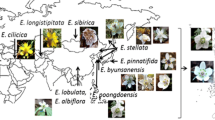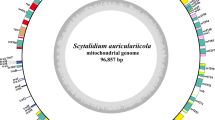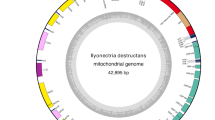Abstract
The mitochondrial genome of an isolate of Phytophthora ramorum from Europe (EU) was sequenced and compared to the previously published genome sequence of an isolate from California (NA). The EU mitochondrial genome had the identical gene order and encoded for the same suite of genes as the NA mitochondrial genome, but had 13 single nucleotide polymorphisms (SNPs) and at 39,494 bp was 180 bp longer. This length difference was due to an increase in the size of the spacer region between the nad5 and nad6 genes caused by a chimeric region containing duplication of the spacer sequence and additional sequences from the flanking genes. Recombination between the 1,150 bp-inverted repeats (IR) generated orientational isomers where the gene order was reversed between the IR. A total of seven primer pairs were developed for amplification of regions where the SNPs were located and two other regions where additional SNPs were encountered when a larger number of isolates were examined. Sequence data for a total of 5,743 bp for 40 isolates collected from a range of geographic areas was compared and 28 loci were found to be polymorphic. The combination of these polymorphisms revealed a total of 4 mitochondrial haplotypes; the traditional EU (haplotype I), the traditional NA (haplotype IIa), the third nuclear lineage of the pathogen recovered from a nursery in Washington State (haplotype III) and a new haplotype representing a subgroup of NA isolates from an Oregon forest (haplotype IIb). Phylogenetic analysis using the sequences generated from the haplotype analysis supported a high affinity for haplotypes IIa and IIb, both of which were distinct from haplotype I, with haplotype I basal to these and haplotype III representing the ancestral state.





Similar content being viewed by others
References
Anonymous (2002) Phytophthora ramorum. Code of Federal Regulations, Title 7, Pt. 301, Subpart 92. pp 142–148
Avila-Adame C, Gomez-Alpizar L, Zismann V, Jones KM, Buell CR, Beagle Ristaino J (2005) Mitochondrial genome sequences and molecular evolution of the Irish potato famine pathogen, Phytophthora infestans. Curr Genet 49:39–46
Ayers WA, Lumsden RD (1975) Factors affecting production and germination of oospores of three Pythium species. Phytopathology 65:1094–1100
Boyd DA, Hobman TC, Gruenke SA, Klassen GR (1984) Evolutionary stability of mitochondrial DNA organization in Achlya. Can J Biochem Cell Biol 62:571–576
Brasier CM (2003) Sudden Oak death: Phytophthora ramorum exhibits transatlantic differences. Mycol Res 107:258–259
Brudno M, Do CB, Cooper GM, Kim MF, Davydov E, Green ED, Sidow A, Batzoglou S (2003) NISC comparative sequencing program. LAGAN and Multi-LAGAN: Efficient Tools for Large-Scale Multiple Alignment of Genomic DNA. Genome Res 13:721–731
California Department of Food and Agriculture (2003) CDFA Plant Quarantine Manual, Sect. 301.92 Phytophthora ramorum. 224.1–224.5
Canadian Food Inspection Agency (2003) Phytosanitary requirements to prevent entry of Phytophthora ramorum associated with sudden oak death into Canada. Directive D-01-01 February 7,2003
Frazer KA, Pachter L, Poliakov A, Rubin EM, Dubchak I (2004) VISTA: computational tools for comparative genomics. Nucleic Acids Res 32:(web server issue) W273–W279
Gordon D (2004) Viewing and editing assembled sequences using consed. In: Baxevanis D, Dawvison DB (eds) Current protocols in bioinformatics. Wiley, New York, pp 11.2.1–11.2.43
Gordon D, Abajian C, Green P (1998) Consed: a graphical tool for sequence finishing. Genome Res 8:195–202
Grayburn WS, Hudspeth DSS, Gane MK, Hudspeth MES (2004) The mitochondrial genome of Saprolegnia ferax: organization, gene content, and nucleotide sequence. Mycologia 96:980–987
Hansen EM, Reeser PW, Sutton W, Winton LM, Osterbauer N (2003) First report of A1 mating type of Phytophthora ramorum in North America. Plant Dis 87:1267
Hudspeth MES, Shumard DS, Bradford JR, Grossman LI (1983) Organization of Achlya mtDNA: a population with two orientation and a large inverted repeat containing the rRNA genes. Proc Nat Acad Sci USA 80:142–146
Ivors K, Garbelotto M, Vries I-DE, Ruyter-Spira C, Hekkert Bt, Rosenzweig N, Bonants P (2006) Microsatellite markers identify three lineages of Phytophthora ramorum in US nurseries, yet single lineages in US forest and European nursery populations. Mol Ecol 15:1439–1505
Ivors KL, Hayden KJ, Bonants P-JM, Rizzo DM, Garbelotto M (2004) AFLP and phylogenetic analyses of North American and European populations of Phytophthora ramorum. Mycol Res 108:378–392
Kroon L-PNM, Verstappen E-CP, Kox L-FF, Flier WG, Bonants P-JM (2004) A rapid diagnostic test to distinguish between American and European populations of Phytophthora ramorum. Phytopathology 94:613–620
Lowe TM, Eddy SR (2007) tRNAscan-SE: a program for improved detection of transfer RNA genes in genomic sequence. Nucleic Acids Res 25:955–964
Martin FN (2000) Phylogenetic relationships among some Pythium species inferred from sequence analysis of the mitochondrially encoded cytochrome oxidase II gene. Mycologia 92:711–727
Martin FN, Bensasson D, Tyler BM, Boore JL (2007) Mitochondrial genome sequences and comparative genomics of Phytophthora ramorum and P. sojae. Curr Genet 51:285–296
Martin FN, Kistler HC (1990) Species-specific banding patterns of restriction endonuclease—digested mitochondrial DNA from the genus Pythium. Exp Mycol 14:32–46
Martin FN, Tooley PW (2003) Phylogenetic relationships among Phytophthora species inferred from sequence analysis of mitochondrially encoded cytochrome oxidase I and II genes. Mycologia 95:269–284
Martin FN, Tooley PW, Blomquist C (2004) Molecular detection of Phytophthora ramorum, the causal agent of sudden oak death in California, and two additional species commonly recovered from diseased plant material. Phytopathology 94:621–631
Mayor C, Brudno M, Schwartz JR, Poliakov A, Rubin EM, Frazer KA, Pachter LS, Dubchak I (2000) VISTA: visualizing global DNA sequence alignments of arbitrary length. Bioinformatics 16:1046
Paquin B, Laforest M-J, Forget L, Roewer I, Wang Z, Longcore J, Lang BF (1997) The fungal mitochondrial genome project: evolution of fungal mitochondrial genomes and their gene expression. Curr Genet 31:380–395
Prospero S, Hansen EM, Grunwald NJ, Winton LM (2007) Population dynamics of the sudden oak death pathogen Phytophthora ramorum in Oregon from 2001 to 2004. Mol Ecol 16:2958–2973
Rizzo DM, Garbelotto M, Davidson JM, Slaughter GW, Koike ST (2002) Phytophthora ramorum as the cause of extensive mortality of Quercus spp. and Lithocarpus densiflorus in California. Plant Dis 86:205–214
Schena L, Cooke DEL (2006) Assessing the potential of regions of the nuclear and mitochondrial genome to develop a “molecular tool box” for the detection and characterization of Phytophthora species. J Microbiol Meth 67:70–85
Werres S, Marwitz R, Man I, Cock A-WAM, Bonants P-JM, Weerdt Md, Themann K, Ilieva E, Baayen RP (2001) Phytophthora ramorum sp. nov., a new pathogen on Rhododendron and Viburnum. Mycol Res 105:1155–1165
Werres S, Merlier Dd (2003) First detection of Phytophthora ramorum mating type A2 in Europe. Plant Dis 87:1266
Acknowledgments
The author would like to thank Paul Richardson and all of the members of the JGI Production Sequencing Department for providing the raw sequence data used in determining the mitochondrial genomic sequences of CBS101553. Thanks also to Mike Coffey and Nik Grunwald for providing extracted DNA for 6 and 16 isolates, respectively, of P. ramorum. Portions of this project were supported by grant 2007-55605-17835 from the USDA-CSREES Plant Biosecurity Grant Program, which is gratefully acknowledged. Mention of trade names or commercial products in this manuscript is solely for the purpose of providing specific information and does not imply recommendation or endorsement by the US Department of Agriculture.
Author information
Authors and Affiliations
Corresponding author
Additional information
Communicated by L.Tomaska.
Rights and permissions
About this article
Cite this article
Martin, F.N. Mitochondrial haplotype determination in the oomycete plant pathogen Phytophthora ramorum . Curr Genet 54, 23–34 (2008). https://doi.org/10.1007/s00294-008-0196-8
Received:
Revised:
Accepted:
Published:
Issue Date:
DOI: https://doi.org/10.1007/s00294-008-0196-8




